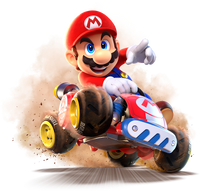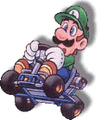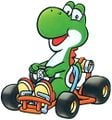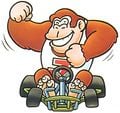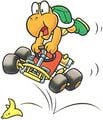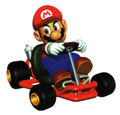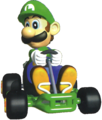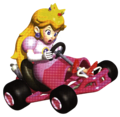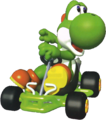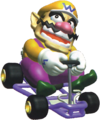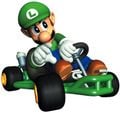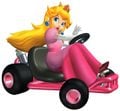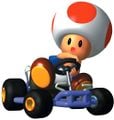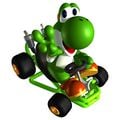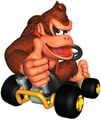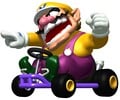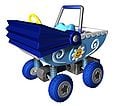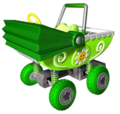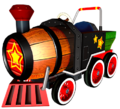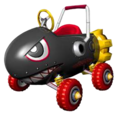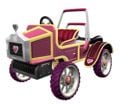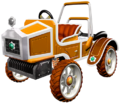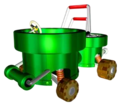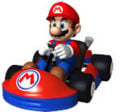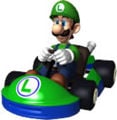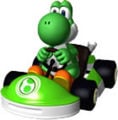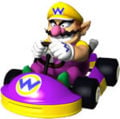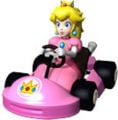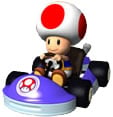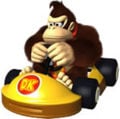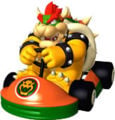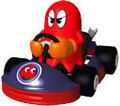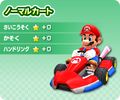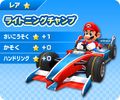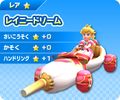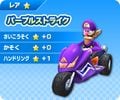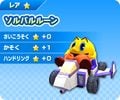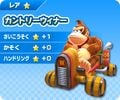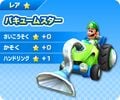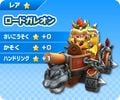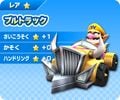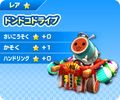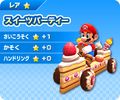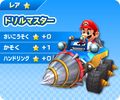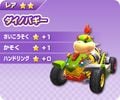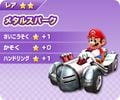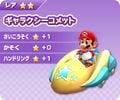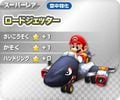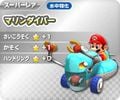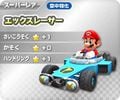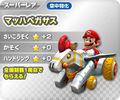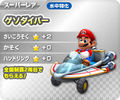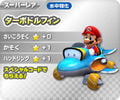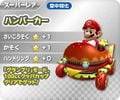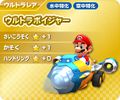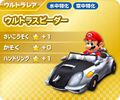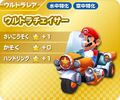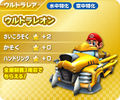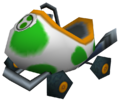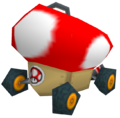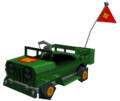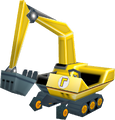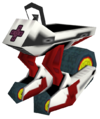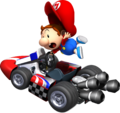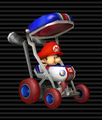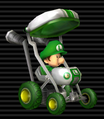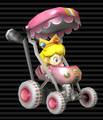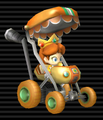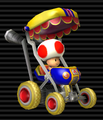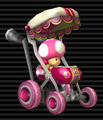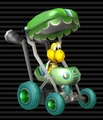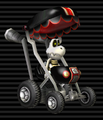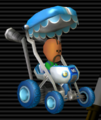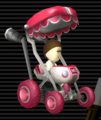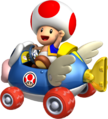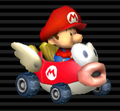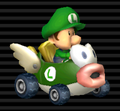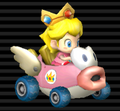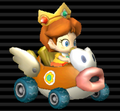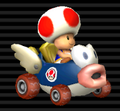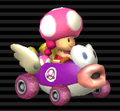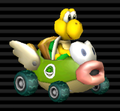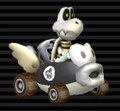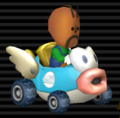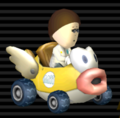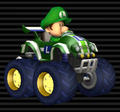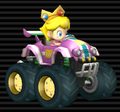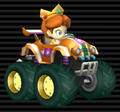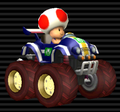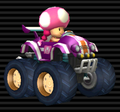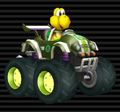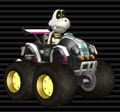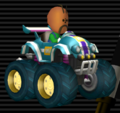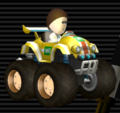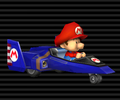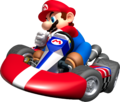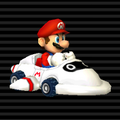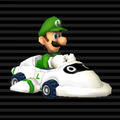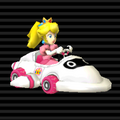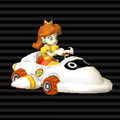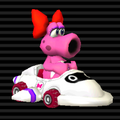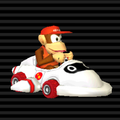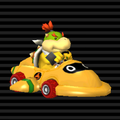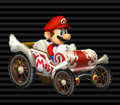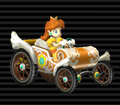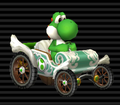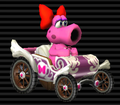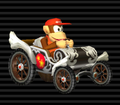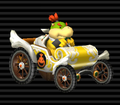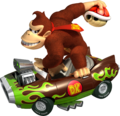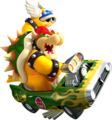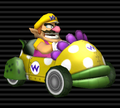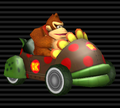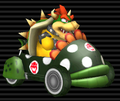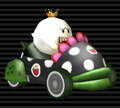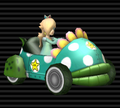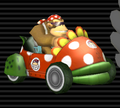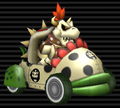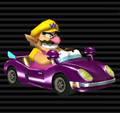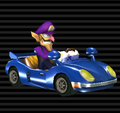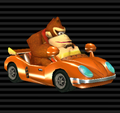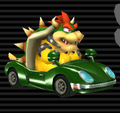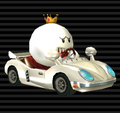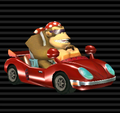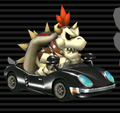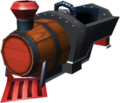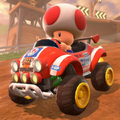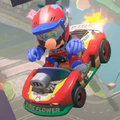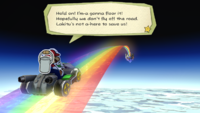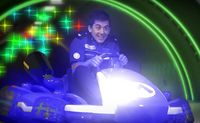Kart
- Not to be confused with Car.
Karts are featured as the main vehicles in the Mario Kart series. They can come in various sizes and colors, corresponding to the size and color of each character. Early Mario Kart games only have one kart, the Go-Kart. Later games include multiple kinds of karts, and allow the player to choose which one to use. Each kart has a distinct appearance and stats such as speed, acceleration and handling. Usually, the kart that is closest to average in terms of stats in each game is defined as the Standard Kart. In such games, the Go-Kart from the older games is recontextualized as the Pipe Frame and given distinct stats. Also, while not initially part of karts, later games have each kart include one or more spaces to display the driver's emblem.
Karts have also appeared in other game series and media such as in the Super Smash Bros. series, comics, and toys.
History[edit]
Mario Kart series[edit]
Super Mario Kart[edit]
In Super Mario Kart, Go-Karts are the only kart in the game. The term "kart" also applies to the extra lives a driver has in Grand Prix mode. In the mode, all drivers start out with three karts, and one kart is lost when a driver comes in 5th place or lower or by retrying a race. When all karts are lost, the player is forced to exit to the title screen. It is possible to regain one more kart in the Grand Prix by placing the same position three times in a row.
Mario's Go-Kart
Luigi's Go-Kart
Princess's Go-Kart
Yoshi's Go-Kart
Bowser's Go-Kart
Donkey Kong Jr.'s Go-Kart
Koopa Troopa's Go-Kart
Toad's Go-Kart
Mario Kart 64[edit]
Go-Karts return in Mario Kart 64, with slight design changes and new sounds. Depending on the characters that use them, karts pertain to one of three weight classes: light, medium, and heavy. Lights are karts that show a high speed but a fairly low endurance. Medium karts show all-around traits, whereas Heavy karts have high endurance but poor speed.
Mario's Go-Kart
Luigi's Go-Kart
Peach's Go-Kart
Toad's Go-Kart
Yoshi's Go-Kart
Donkey Kong's Go-Kart
Bowser's Go-Kart
Wario's Go-Kart
Mario Kart: Super Circuit[edit]
Go-Karts reappear in Mario Kart: Super Circuit with the same traits as in Mario Kart 64. The player can press to sound the horn on the kart during a race in the game.
Mario's Go-Kart
Luigi's Go-Kart
Peach's Go-Kart
Toad's Go-Kart
Yoshi's Go-Kart
Donkey Kong's Go-Kart
Wario's Go-Kart
Bowser's Go-Kart
Mario Kart: Double Dash!![edit]
In Mario Kart: Double Dash!!, there are new karts with new appearances and styles. Most of them reflect a character's special characteristics, such as Mario's Red Fire, which is a red and blue-colored all-terrain vehicle, rendering Mario's letter M emblem on its body and wheels. In this game, the karts have a seat on the front where a character drives the kart and a platform in the rear of the vehicle where the second character is able to use an item, taken from the Item Boxes. Similarly to previous games, the karts are split in the Light, Medium, and Heavy weight groups, though drivers can only use karts that fit their own weight. The Parade Kart breaks this rule, being usable for any character. The player can press the item button (![]() /
/![]() ) (without the rear character holding an item) to sound the horn, and the rear player makes a small pose.
) (without the rear character holding an item) to sound the horn, and the rear player makes a small pose.
Every kart has its own stats, which are qualified by the amount of stars on its acceleration, speed, and weight. In general however, lightweight karts have a high acceleration, but a fair low speed and endurance. Medium-weight karts have balanced stats, whereas heavyweight karts show a high top speed and endurance, and low acceleration. There are twenty-one karts in the game.
Lightweight[edit]
Medium weight[edit]
Heavyweight[edit]
Any weight[edit]
Mario Kart Arcade GP subseries[edit]
In Mario Kart Arcade GP, all the characters use a kart with rounded details and a solid build as opposed to other previous Mario Kart games. However, in Mario Kart Arcade GP 2, the characters have an option to choose a secondary kart that was made for them. In Mario Kart Arcade GP DX, there are now different karts that can be used by drivers.
Just as in Mario Kart: Double Dash!!, all the karts are rated by the amount of the stars for each aspect. Regarding to the character selected, they can be light, medium, or heavy, emphasizing one of these aspects for the vehicle available. Some karts return in later installments and are listed in bold.
Mario Kart Arcade GP[edit]
Mario Kart Arcade GP 2[edit]
Standard[edit]
Personal[edit]
Mario Kart Arcade GP DX[edit]
Mario Kart DS[edit]
In Mario Kart DS, Standard Karts replace Go-Karts in the game. These karts are redesigned, having white bumpers and a frame of different color palettes that matches the character's custom color. The emblem of the character is shown over the hood, although the player can replace it with their own in the emblem maker option. Additionally, every character can select at least one of three vehicles (excluding Shy Guy, having only his Standard SG), exclusive for being rather different in design and stats than the character's Standard Kart. While a Standard Kart has plain stats, the other vehicles can have a high speed, acceleration or items ratio, depending on what the vehicle is made for. Every Kart is qualified by six ratings:
- Acceleration: The time for achieving the top speed. Lightweight karts like Yoshi's Standard YS have the highest acceleration rating.
- Speed: The top speed level when a kart moves forward. Most of the karts within the heavyweight class show the highest speed rating.
- Weight: The kart's endurance. When a kart has a higher weight, it is capable of knocking lighter karts further.
- Drifting: The friction power of the kart when turns by powersliding. A high drifting rate makes the kart turn tighter.
- Handling: The control over the vehicle in all type of terrains. The strength of the Mini-Turbo boost caused by drifting also depends on how high the kart's handling is.
- Items: The variety of items to obtain in an Item Box. As the kart's item stat is high, the character can receive rarer items more commonly. The smaller the kart's wheels, the lower the meter is for the Items stat.
Mario's Standard MR
Mario's Shooting Star
Luigi's Standard LG
Luigi's Streamliner
Peach's Standard PC
Peach's Light Tripper
Yoshi's Standard YS
Yoshi's Cucumber
Toad's Standard TD
Toad's 4-Wheel Cradle
Donkey Kong's Standard DK
Donkey Kong's Wildlife
Wario's Standard WR
Wario's Dragonfly
Bowser's Standard BW
Bowser's Hurricane
Daisy's Standard DS
Daisy's Light Dancer
Dry Bones' Standard DB
Dry Bones' Dry Bomber
Waluigi's Standard WL
Waluigi's Zipper
R.O.B.'s Standard RB
R.O.B.'s ROB-LGS
Mario Kart Wii[edit]
In Mario Kart Wii, karts are once again redesigned with various details added than they appeared formerly. Similar to Mario Kart DS, the typical go-karts receive the name of Standard Karts, and are classified according to the size of the vehicle, split in three groups: Standard Kart S for small-sized characters; Standard Kart M for medium size characters and Standard Kart L for large characters. Though weight classes are replaced for size classes, the general aspects of the karts are the same as appeared throughout the series.
- Speed: The level of the top speed.
- Weight: The strength of the vehicle to knock apart others.
- Acceleration: The time to achieve the top speed.
- Handling: The control of the vehicle.
- Drift: The friction power of the vehicle.
- Off-road: The speed of the vehicle over rough terrain.
- Mini-turbo: The power of the momentary speed burst after drifting or making a trick.
The Karts and newly-introduced Bikes can be divided into six classes of vehicle counterparts based on their stats. In addition, each racer can vary the kart's custom stats with the bonus points they have for each feature and select other five karts in the determined character's size. Unlike in other games, every kart has a unique color scheme for the players using it. Unlike Bikes, Karts cannot perform wheelies. However, they can release a more powerful boost by drifting than a bike, depending how long the respective button is pressed. Compared to bikes, karts generally offer superior speed and weight in exchange for being weaker in every other stat. Additionally, bikes have six trick variants while karts only have three.
Small karts[edit]
Baby Mario tricking on his Standard Kart S
Koopa Troopa driving his Standard Kart S with rotating Green Shells
Baby Luigi's Standard Kart S
Baby Mario's Booster Seat/Baby Booster
Baby Peach's Booster Seat/Baby Booster
Baby Daisy's Booster Seat/Baby Booster
Toad's Booster Seat/Baby Booster
Toadette's Booster Seat/Baby Booster
Dry Bones' Booster Seat/Baby Booster
Male Mii's Booster Seat/Baby Booster
Baby Mario's Mini Beast/Concerto
Toad driving his Cheep Charger
Baby Peach driving her Cheep Charger and dropping Bananas
Baby Mario's Tiny Titan/Rally Romper
Baby Mario's Blue Falcon
Medium karts[edit]
Mario driving his Standard Kart M
Mario's Classic Dragster/Nostalgia 1
Luigi's Classic Dragster/Nostalgia 1
Peach's Classic Dragster/Nostalgia 1
Daisy's Classic Dragster/Nostalgia 1
Yoshi's Classic Dragster/Nostalgia 1
Birdo's Classic Dragster/Nostalgia 1
Diddy Kong's Classic Dragster/Nostalgia 1
Bowser Jr.'s Classic Dragster/Nostalgia 1
Mario's Super Blooper/Turbo Blooper
Mario's Daytripper/Royal Racer
Mario's Sprinter/B Dasher Mk. 2
Large karts[edit]
Wario driving his Standard Kart L
Rosalina's Standard Kart L
Wario's Offroader
Waluigi's Offroader
Donkey Kong's Offroader
Bowser's Offroader
King Boo's Offroader
Funky Kong's Offroader
Dry Bowser's Offroader
Donkey Kong driving his Flame Flyer and preparing to throw a Red Shell
Bowser driving his Flame Flyer and preparing to throw a Spiny Shell
Wario's Piranha Prowler
Wario's Jetsetter/Aero Glider
Wario's Honeycoupe/Dragonetti
Battle Mode[edit]
Mario Kart 7[edit]
Karts return in Mario Kart 7, with the Standard Karts having a similar design to their appearance from Mario Kart DS. Karts now deploy gliders if a character is propelled in the air from a high place to help them glide, and when underwater, a propeller appears at the back to help push the kart along. Players are able to customize their karts as well by selecting different tires and gliders.
Returning[edit]
New[edit]
Gold Standard (Gold Kart)
Birthday Girl (Royal Ribbon)
Bruiser (Growlster)
Zucchini (Gherkin)
Mario Kart 8 / Mario Kart 8 Deluxe[edit]
Karts return in Mario Kart 8. In the game, kart wheels go horizontal when racing in anti-gravity. Like in Mario Kart 7, the players are able to choose the bodies, wheels, and gliders for their karts. The Pipe Frame and Gold Standard return from Mario Kart 7 with slightly different appearances. The player can also press the player icon on the to sound the horn (or press the item button when there's no item being held), a feature absent since Mario Kart: Double Dash!!. Karts also come equipped with lights, which turn on when karts enter a tunnel or a dark area.
Three additional karts are available for free (the GLA, W 25 Silver Arrow and the 300 SL Roadster), while eight more are paid DLC. In the enhanced Nintendo Switch port Mario Kart 8 Deluxe, all the kart parts from Mario Kart 8 return as base game content, including the DLC parts, and some new karts are added.
Returning[edit]
Gold Standard (Gold Kart)
Koopa Clown (Deluxe only)
New[edit]
Biddybuggy (Buggybud)
Sneeker (Bounder)
Sports Coupe (Sports Coupé)
Mario Kart Tour[edit]
Karts reappear in Mario Kart Tour, where they are acquired randomly through Pipes or Spotlight Shop, which cost rubies. In addition, like gliders and drivers, karts are sorted into three rarities: Normal, Super, and High-End. Super karts are rarer than Normal karts, and High-End karts are rarer than Super karts. Players no longer choose tires for their kart, with each kart having its own tires conferring no changes, but do continue to choose gliders.
Also like gliders and drivers, karts have base points which that are immediately granted to the player's score at the start of each race. Rarer karts have more base points. Using karts in races or using Point-boost tickets on them will cause them to gain experience points that will at certain breakpoints increase the kart's base points. Karts can be leveled up by obtaining additional copies of the kart or by using Level-boost tickets to multiply the amount of points the player receives for performing any kind of action, with Super karts starting with a small multiplier and High-End karts starting with a slightly larger multiplier.
While karts do not have different stats, they each have a different special skill that will increase the boost provided and points earned for using a specific kind of technique. Further, each kart has some amount of favored and favorite courses, with rarer karts having more such courses. When a kart is used on one of its favored courses, the player earns 1.5 times the number of points they would normally earn for every action. On a favorite course, they instead earn two times the points.
Returning[edit]
Normal[edit]
Pipe Frame

Slipstream PlusBirthday Girl

Dash Panel PlusMushmellow

Jump Boost PlusKoopa Dasher

Rocket Start PlusBiddybuggy

Slipstream PlusCheep Charger

Jump Boost PlusBullet Blaster

Rocket Start PlusLandship

Mini-Turbo Plus
Super[edit]
Mach 8

Slipstream PlusDaytripper

Dash Panel PlusTurbo Yoshi

Jump Boost PlusSoda Jet

Mini-Turbo PlusSuper Blooper

Mini-Turbo PlusRoyale

Slipstream PlusCloud 9

Jump Boost PlusPoltergust 4000

Slipstream PlusStreamliner

Slipstream PlusZucchini

Mini-Turbo PlusBlue Seven

Rocket Start PlusEgg 1

Mini-Turbo PlusCucumber

Slipstream PlusFlame Flyer

Rocket Start PlusBarrel Train

Rocket Start PlusDK Jumbo

Jump Boost PlusKoopa Clown

Mini-Turbo PlusPara-Wing

Jump Boost PlusTurbo Birdo

Mini-Turbo PlusBolt Buggy

Slipstream PlusRambi Rider

Rocket Start Plus
High-End[edit]
B Dasher

Dash Panel PlusCircuit Special

Slipstream PlusBumble V

Dash Panel PlusWild Wing

Dash Panel PlusP-Wing

Mini-Turbo PlusPrancer

Slipstream PlusSports Coupe

Rocket Start PlusSteel Driver

Slipstream PlusCat Cruiser

Mini-Turbo PlusB Dasher Mk. 2

Dash Panel PlusTanooki Kart

Slipstream PlusSneeker

Rocket Start PlusDragonfly

Slipstream PlusGoo-Goo Buggy

Rocket Start PlusGold Standard

Slipstream PlusStreetle

Jump Boost PlusBadwagon

Mini-Turbo PlusBruiser

Jump Boost PlusOffroader

Jump Boost PlusKoopa King

Rocket Start PlusCact-X

Slipstream PlusPiranha Pipes

Jump Boost PlusBoo Pipes

Slipstream PlusWild Wiggler

Jump Boost Plus
New[edit]
Normal[edit]
Blue Biddybuggy[a]

Slipstream PlusPink Mushmellow

Dash Panel PlusBirthday Girl Rosalina[a]

Slipstream PlusGreen Kiddie Kart

Rocket Start PlusRed Kiddie Kart

Slipstream PlusBull's-Eye Banzai

Rocket Start PlusPipe Buggy

Slipstream PlusWarship

Mini-Turbo PlusGreen Cheep Charger

Jump Boost Plus
Super[edit]
Gold Blooper

Mini-Turbo PlusWhite Royale

Rocket Start PlusRed Streamliner

Slipstream PlusRed Turbo Yoshi

Rocket Start PlusSuper 1

Jump Boost PlusDasher II

Dash Panel PlusTea Coupe

Jump Boost PlusYellow Turbo Birdo

Dash Panel PlusBirthday Girl Daisy[a]

Rocket Start PlusRed Standard 8[a]

Mini-Turbo PlusGreen Standard 8[a]

Jump Boost PlusBlue Royale

Jump Boost PlusBlue Turbo Yoshi

Slipstream PlusOrange Turbo Yoshi

Dash Panel PlusPink Turbo Yoshi

Slipstream PlusLight-blue Turbo Yoshi

Rocket Start PlusYellow Turbo Yoshi

Jump Boost PlusChrome DK Jumbo

Jump Boost PlusDark Clown

Mini-Turbo PlusLight-blue Turbo Birdo

Rocket Start PlusBlue Turbo Birdo

Jump Boost PlusOrange Turbo Birdo

Dash Panel PlusRed Turbo Birdo

Jump Boost PlusGreen Turbo Birdo

Mini-Turbo Plus
High-End[edit]
Black B Dasher

Dash Panel PlusYellow Taxi

Jump Boost PlusQuickshaw

Rocket Start PlusKabuki Dasher

Dash Panel PlusBlack Circuit[a]

Slipstream PlusQueen Bee

Dash Panel PlusTrickster

Dash Panel PlusGhost Ride

Rocket Start PlusMacharon

Jump Boost PlusCarrot Kart

Mini-Turbo PlusCheermellow

Rocket Start PlusRadish Rider

Slipstream PlusWildfire Flyer

Jump Boost PlusRibbon Rider

Mini-Turbo PlusDouble-Decker

Dash Panel PlusSwift Jack

Slipstream PlusRed B Dasher

Rocket Start PlusJingle Bells

Dash Panel PlusPlatinum Taxi

Mini-Turbo PlusGlam Bruiser

Slipstream PlusGilded Prancer

Jump Boost PlusIce-blue Poltergust

Dash Panel PlusApple Kart

Jump Boost PlusComet Tail

Dash Panel PlusBright Bunny

Jump Boost PlusDozer Dasher

Dash Panel PlusClanky Kart

Jump Boost PlusWild Black

Mini-Turbo PlusKarp Kart

Rocket Start PlusRose Queen

Mini-Turbo PlusGreen Apple Kart

Slipstream PlusChoco Macharon

Mini-Turbo PlusGold Egg

Jump Boost PlusSweet Daytripper

Rocket Start PlusRed Taxi

Dash Panel PlusPink Wing

Slipstream PlusHappy Ride

Mini-Turbo PlusBlue Soda

Dash Panel PlusClackety Kart

Mini-Turbo PlusGold Clanky Kart

Dash Panel PlusFestival Girl

Jump Boost PlusBlack Kabuki Dasher

Mini-Turbo Plus8-Bit Pipe Frame

Mini-Turbo PlusGold Pipe Frame

Jump Boost PlusSurf Sailer

Dash Panel PlusStar-Spangled Flyer

Mini-Turbo PlusGreen Circuit[a]

Jump Boost PlusPumpkin Kart

Mini-Turbo PlusDark Trickster

Jump Boost PlusSunset Cloud

Dash Panel PlusHoliday King

Slipstream PlusGold Snow Skimmer

Rocket Start PlusDreamy Egg

Dash Panel PlusFast Frank

Jump Boost PlusIron Cucumber

Rocket Start PlusRose Taxi

Slipstream PlusDecal Streamliner

Jump Boost PlusOrange Streamliner

Rocket Start PlusWhite Turbo Yoshi

Dash Panel PlusSakura Quickshaw

Slipstream PlusJet Cruiser

Rocket Start PlusInferno Flyer

Slipstream PlusRambi Runner

Mini-Turbo PlusPink Dozer

Jump Boost PlusGrand Badwagon

Slipstream PlusPaintster

Dash Panel PlusLime Tea Coupe

Mini-Turbo PlusSunny Surf Sailer

Rocket Start PlusPinch Hitter

Slipstream PlusCleanup Hitter

Mini-Turbo PlusIce Dozer

Mini-Turbo PlusGreen Double-Decker

Slipstream PlusBlack Cat Cruiser

Dash Panel PlusRed B Dasher Mk. 2

Dash Panel PlusPink B Dasher Mk. 2[a]

Jump Boost PlusClassic B Dasher Mk. 2

Rocket Start PlusSky-Blue B Dasher Mk. 2

Mini-Turbo PlusMetal B Dasher Mk. 2

Rocket Start PlusCream B Dasher Mk. 2[a]

Jump Boost PlusGreen B Dasher Mk. 2[a]

Slipstream PlusGold Pumpkin Kart

Rocket Start PlusLunar Cruiser

Rocket Start PlusSleigh Rider

Mini-Turbo PlusWhite Snow Skimmer

Slipstream PlusFrosty Bells

Jump Boost PlusFrost Wing

Dash Panel PlusGray Cat Cruiser

Rocket Start PlusSports Coupe 2022

Mini-Turbo PlusRoaring Racer

Slipstream PlusJukebox Buggy

Jump Boost PlusGreen Lightning

Dash Panel PlusCupid's Arrow

Jump Boost PlusWild Slugger

Dash Panel PlusProp Kart

Jump Boost PlusMagma Broom

Mini-Turbo PlusStar Broom

Rocket Start PlusYellow 8-Bit Pipe Frame

Dash Panel PlusWarrior Wagon

Mini-Turbo PlusArmored Rider

Slipstream PlusBlack Turbo Yoshi

Mini-Turbo PlusGold Bunny

Slipstream PlusFlower Kart

Jump Boost PlusFirefly

Rocket Start PlusDaikon Rocket

Dash Panel PlusCapsule Kart

Dash Panel PlusBlue-Green Capsule Kart

Slipstream PlusWhite Bruiser

Mini-Turbo PlusCoconut 1

Rocket Start PlusPink Capsule Kart

Jump Boost PlusCream Cat Cruiser

Jump Boost PlusGreen Cat Cruiser

Slipstream PlusGoo-Goo Pink

Mini-Turbo PlusGold Kiddie Kart

Dash Panel PlusSweet Ride

Mini-Turbo PlusWhite Fast Frank

Rocket Start PlusTuk-Tuk Kart

Dash Panel PlusTropical Truck

Rocket Start PlusGold Zucchini

Slipstream PlusLightning Streamliner

Mini-Turbo PlusFlowery Badwagon

Dash Panel PlusCoral Jet Cruiser

Slipstream PlusWatermelon Kart

Rocket Start PlusIce-Cream Minibus

Mini-Turbo PlusChocolate Banana Minibus

Rocket Start PlusStrawberry Soft Swerve

Slipstream PlusShielded Speedster

Jump Boost PlusGold Double-Decker

Rocket Start PlusBlack Carriage

Dash Panel PlusGreen Speeder[a]

Slipstream PlusFlaming Speeder

Dash Panel PlusGold Sweet Ride

Jump Boost PlusBlue Speeder

Mini-Turbo PlusSwift Talon

Jump Boost PlusGold Eagle

Rocket Start PlusBlazing Eagle

Slipstream PlusCamo Tanooki Kart

Mini-Turbo PlusGold Rambi Rider

Jump Boost PlusMoo Moo Offroader

Dash Panel PlusPink Speeder[a]

Jump Boost PlusPink Sneeker

Slipstream PlusGold Jingle Bell

Mini-Turbo PlusHoliday Speeder

Rocket Start PlusWild Gold

Rocket Start PlusRainbow Taxi

Rocket Start PlusBlooper Shuttle

Dash Panel PlusGold Lunar Cruiser

Jump Boost PlusGold Quickshaw

Mini-Turbo PlusPineapple 1

Slipstream PlusHot Pot Hot Rod

Jump Boost PlusRainbow Streetle

Mini-Turbo PlusGold Capsule Kart

Dash Panel PlusGold 8-Bit Pipe Frame

Rocket Start PlusTaiko Drum Dasher

Mini-Turbo PlusSakura Sports Coupe

Dash Panel PlusBright Girl

Jump Boost PlusHuffin Puffin Egg

Mini-Turbo PlusJumbo Jetter

Slipstream PlusGold Paintster

Rocket Start PlusSilver Flower Kart

Dash Panel PlusBronze Cucumber

Jump Boost PlusCream Classic

Mini-Turbo PlusRed Comet

Slipstream PlusPink Comet

Mini-Turbo PlusGreen Comet

Jump Boost PlusGold Comet

Rocket Start PlusMach 8-R

Dash Panel PlusGold Cupid's Arrow

Rocket Start PlusSilver Cupid's Arrow

Slipstream PlusSilver Warrior Wagon

Dash Panel PlusGold Warrior Wagon

Rocket Start PlusBlack Shielded Speedster

Slipstream PlusGold Shielded Speedster

Mini-Turbo PlusYeehaw Wagon

Dash Panel PlusDesert Rose Wagon

Dash Panel PlusYellow Sub Scooter

Slipstream PlusBlue Sub Scooter

Mini-Turbo PlusGold Driver

Dash Panel PlusDolphin Drifter

Jump Boost PlusPurple Rattle Buggy

Slipstream PlusGoo-Goo Gold

Dash Panel PlusGold Wild Slugger

Rocket Start PlusSpicy Zucchini

Dash Panel PlusChocolate Mint Soft Swerve

Mini-Turbo PlusGold Soft Swerve

Rocket Start PlusMonarch Kart

Dash Panel PlusGold Monarch Kart

Rocket Start PlusBlack B Dasher Mk. 2

Slipstream PlusGold B Dasher

Jump Boost PlusBlue Badwagon

Mini-Turbo PlusGold Train

Rocket Start PlusSnow Skimmer

Jump Boost PlusBanana Master

Mini-Turbo PlusPoison Apple Kart

Dash Panel PlusCheep Snorkel

Jump Boost PlusGold Cheep Charger

Mini-Turbo PlusGold Cheep Snorkel

Rocket Start PlusDark Buggy

Jump Boost PlusBrown Offroader

Dash Panel PlusPirate Sushi Racer

Rocket Start PlusSilver Bullet Blaster

Jump Boost PlusHead Honcho

Mini-Turbo PlusDK Maximum

Dash Panel PlusSushi Racer

Slipstream PlusGilded King

Dash Panel PlusCrawly Kart

Slipstream PlusBlack Dozer

Rocket Start PlusParty-Wing

Mini-Turbo PlusPenguin Slider

Dash Panel PlusBlack Penguin Slider

Rocket Start PlusCact-Ice

Dash Panel PlusBlack Turbo Birdo

Slipstream PlusPurple Bunny

Rocket Start PlusJade Hop Rod

Jump Boost PlusCrimson Hop Rod

Dash Panel PlusDark Hop Rod

Mini-Turbo PlusKamek's Zoom Broom

Jump Boost PlusSilver King

Mini-Turbo PlusVampire Flyer

Jump Boost PlusRed Crawly Kart

Dash Panel PlusYellow Offroader

Mini-Turbo PlusCact-R

Rocket Start PlusCheership

Slipstream PlusCandy Clown

Dash Panel PlusTiger Bruiser

Dash Panel PlusCombo Cruiser

Mini-Turbo PlusSakura Hop Rod

Rocket Start PlusWhite Turbo Birdo

Rocket Start PlusGreen-Yellow Capsule Kart

Rocket Start PlusRed Offroader

Slipstream PlusGoo-Goo Black

Jump Boost PlusCact-B

Mini-Turbo PlusGold Bullet Blaster

Dash Panel PlusRed Vampire Flyer

Slipstream PlusGold Trickster

Rocket Start PlusGold Bruiser

Rocket Start PlusBlack Sneeker[a]

Dash Panel PlusPurple Dozer

Slipstream PlusBlue Crawly Kart

Mini-Turbo PlusRainbow Pipe Buggy

Jump Boost PlusGold Hop Rod

Slipstream PlusBlack Jingle Bell

Slipstream PlusGold Sushi Racer

Jump Boost PlusDry Bones Dasher

Mini-Turbo PlusWaluigi Racer Mk. 2

Jump Boost PlusChain Chomp Chariot

Slipstream PlusFish Bone Ferry

Mini-Turbo PlusGold Fish Bone Ferry

Rocket Start PlusWiggler Egg

Jump Boost PlusGold Pipes

Rocket Start Plus
Mario Kart World[edit]
Karts return in Mario Kart World, with the Standard Karts having a new design that is influenced by Mario Kart 8 and Mario Kart Wii. Unlike in previous games, karts no longer deploy gliders or propellers; instead, they deploy wings that act similarly to gliders and hulls to drive on water instead of underwater, respectively. Like games prior to Mario Kart 7, they have unique sets of tires.
Returning[edit]
New[edit]
Club Nintendo[edit]
"Die Jagd nach dem Nintendo 64: Krawall im All"[edit]
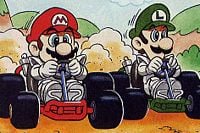
In the Club Nintendo comic "Die Jagd nach dem Nintendo 64: Krawall im All", Mario and Luigi are seen driving karts in their mission to find a spaceship shaped like the Nintendo 64. They compete against Wario and Bowser and they drop Banana Peels to make Wario and Bowser crash. The karts in this comic resemble those from Mario Kart 64. Unlike their video game equivalents, though, they can also be turned into jet skis by pushing a button on their steering-wheels.
Mario Kirby Meisaku Video[edit]
A Pipe Frame appears in the Mario segment of the Mario Kirby Meisaku Video where Mario drives it during his pursuit of W. After being attacked by some monsters, the kart spins out near a vegetable garden.
Super Mario-kun[edit]
Karts are commonly seen in the Mario Kart adaptions of Super Mario-kun, where they are used in races against other racers.
Super Smash Bros. series[edit]
Super Smash Bros. Melee[edit]
In Super Smash Bros. Melee, a red Go-Kart is depicted in a trophy named "Racing Kart". The trophy adds that racing karts are "extremely durable".
Super Smash Bros. Brawl[edit]
In Super Smash Bros. Brawl, karts driven by red Shy Guys are stage hazards on the stage Mario Circuit. The stage's premise is that the Shy Guys are racing around the course, while the fighters battle on a vertical plane at the course's intersection. Thus. the karts drive through the that plane when they pass the intersection and damage the fighters on contact. The way the course is arranged, the karts either drive into the intersection from the background, moving along the road at ground level, or by jumping from left to right across elevated sections of road serving as platforms of the stage. If the fighters attack the karts, the karts are sent flying away. A jumbotron in the background of the stage tracks each racer's position, and it accounts for the setbacks to racers caused by being sent flying.
The karts' design is based on their appearance in Mario Kart DS. While the karts Shy Guys use in Mario Kart DS were only ever grey and black, the karts in this game have one of various colors for their body, and their bumpers and emblems are colored differently as well.
Super Smash Bros. for Nintendo 3DS / Wii U[edit]
- See also: Clown Kart Dash
Karts driven by Shy Guys reappear in Super Smash Bros. for Nintendo 3DS on the new Rainbow Road stage, and in Super Smash Bros. for Wii U on both the new Mario Circuit stage and the one returning from Super Smash Bros. Brawl. The new stages have a similar premise as the the older Mario Circuit, but instead of the fighters being in a static area, the platforms making up the base portion of the stage fly around the course. Usually, this means the karts are unable to reach the fighters, but when the base portion of the stage disappears to have the battle proceed on one of the parts of the course, there is a risk of the karts coming through that part of the course and inflicting damage as before. While neither stage has a map available in the background, graphics appear on screen to indicate when karts are about to drive through. The karts on the new Mario Circuit stage deal less damage than the ones on the older Mario Circuit stage.[1]
Rainbow Road introduces areas where the karts use gliders to navigate the course, so their trajectory is an diagonally downward line compared to the arc of jumping. The new Mario Circuit stage has the karts use anti-gravity on a course designed around it, meaning the karts are able to drive horizontally on a road parallel to the screen or drive toward the screen on a road arranged to act as a wall for the fighters, among other new methods of attacking.
Bowser Jr.'s side special move, Clown Kart Dash, has him transform the Junior Clown Car into a kart to race forward. This can be used for faster movement, to attack enemies, and to help return to the stage after being launched off. The move ends with a damaging spin out. Clown Kart Dash has two variations called Koopa Drift and Grounding Dash, but neither adds extra kart functionality. Bowser Jr.'s down taunt has him do a short spin with the kart form of the Junior Clown Car. One of his victory animations has him drive onto the screen using the kart while holding a hammer, then end by spinning out.
Mario, Luigi, Peach, Bowser, and Donkey Kong race each other on karts on an original Rainbow Road course in Rosalina & Luma's reveal trailer.
Super Smash Bros. Ultimate[edit]
Nearly every stage in the Super Smash Bros. series is present in Super Smash Bros. Ultimate. This includes the Mario Circuit stage from Super Smash Bros. Brawl, renamed Figure-8 Circuit, and the Mario Circuit stage from Super Smash Bros. for Wii U, but not Rainbow Road. This includes their kart obstacles. The Battlefield form and Ω form of Figure 8-Circuit take place on platforms high above the track, so in those forms the karts only race in tbe background and are not hazards. The Battlefield form of Mario Circuit excludes the karts of the stage. Bowser Jr. returns as a playable fighter, including Clown Kart Dash and assorted animations, but excluding Koopa Drift and Grounding Dash.
Paper Mario series[edit]
Paper Mario: The Thousand-Year Door[edit]
In Paper Mario: The Thousand-Year Door, one of Luigi's adventures takes place at Circuit Break Island, where the citizens have kart races every day. Luigi begs Torque to let him drive a kart, called the Big Green 01, and instantly wrecks it. Unable to pay and repair the kart, Torque follows Luigi to Rogueport.
Paper Mario: Color Splash[edit]
In Paper Mario: Color Splash, after Mario collects the green Big Paint Star from the Emerald Circus, it flies off the map to restore Luigi's kart's colors somewhere off-screen before returning to the Prisma Fountain. When the Big Paint Stars form a rainbow road up to Black Bowser's Castle, Luigi drives to Port Prisma in his kart, and he later transports Mario and Huey to the castle. After Mario and Huey defeat Black Bowser and rescue Princess Peach, Luigi, Princess Peach, and Mario drive back to Port Prisma in Luigi's kart. In the game's ending cutscene, the Mustard Café chef is seen sitting in Luigi's kart.
Paper Mario: The Origami King[edit]
In Paper Mario: The Origami King, Luigi uses his kart to drive Mario to Toad Town, stopping in front of Princess Peach's Castle. Later, the kart is seen tipped over at the castle grounds, and Luigi drives it again after being rescued from inside a wall. Near the end of the game, Luigi finds the Key to Peach's Castle in his kart's tailpipe. During the Origami Festival, the Toad mechanic talks to Luigi while riding his kart.
Mario Kart 8 From the Pit[edit]
A kart appeared in the video series Mario Kart 8 From the Pit with Crew Chief Andrew Trego. In one of the episodes, Andrew is sitting on a kart while singing the Super Star theme.
Super Mario series[edit]
Super Mario Maker[edit]
In Super Mario Maker, one of the various forms of Costume Mario is Mario driving a kart. When he is jumping, his kart deploys a glider. The sound effects from Super Mario Kart are heard.
Super Mario Run[edit]
In Super Mario Run, Mario and his kart appears as a statue.
Item description[edit]
- Mario Kart: "Start your engines! Looking at this statue may give you the urge to drift, but try to be careful."
The Super Mario Bros. Movie[edit]
In The Super Mario Bros. Movie, Stuart from the Despicable Me and Minions series uses a kart in the Illumination logo prior to the opening. When Mario, Princess Peach, and Toad arrive at the Jungle Kingdom, the Kong that greets them brings them to Cranky Kong on a kart. When it goes off a ramp, it opens its glider. After Cranky Kong suggests using karts to return to the Mushroom Kingdom, the group go to the kart workshop to build their own vehicles. Mario builds a kart resembling the Standard Kart M and Pipe Frame while Toad builds a kart resembling the Tiny Titan. The group are joined by Donkey Kong, Cranky Kong, and the Kong army on their own karts to drive down the secret passage and Rainbow Road. While the group drive down Rainbow Road, the Koopa Troop ambush them with their own karts. Some resemble the Bullet Bike with Bomber Bill faces, while others are equipped with cannons that fire Green Shells and Bullet Bills. The karts built by the Kong Army are powered by banana juice, while the karts built by the Koopa Troop are powered by lava.[2]
Other appearances[edit]
In the Nintendogs, it is possible to find Mario, Peach, and Bowser Karts from Mario Kart DS, They play the GCN Mario Circuit, GCN Peach Beach, and Bowser's Castle music from Mario Kart: Double Dash!!, respectively, when used. Mario and Peach Karts also return Nintendogs + Cats, with the Bowser Kart being replaced by the Yoshi Kart. When used, Mario, Peach and Yoshi karts play the Mario Circuit, DS Peach Gardens, and DS Yoshi Falls music from Mario Kart Wii, respectively.
Names in other languages[edit]
| Language | Name | Meaning | Notes |
|---|---|---|---|
| Japanese | カート[?] Kāto |
Kart | |
| Catalan | Kart[?] | Kart | The Super Mario Bros. Movie |
| Chinese (Simplified) | 卡丁车[?] Kǎdīngchē |
Kart | |
| Chinese (Traditional) | 賽車[?] Sàichē |
Kart | |
| Hungarian | Kártya [?] |
The word normally means "playing card", but the context (kártya glide) changes its meaning to "kart". | 2020 Mario Kart Kinder Surprise promotion in Romania and Hungary |
| Russian | Карт[?] Kart |
Kart | |
| Spanish | Kart[?] | - |
Notes[edit]
- The Kart appears in Nintendo Monopoly under the name "Mario Kart", where it replaces Reading Railroad as a purchasable vehicle. It costs $200. There is also a Coin Block/Brick Block card that charges the player $150 for renewing their Kart license in the 2006 version, and only $50 in the 2010 version. The ? Block card in both versions allows the player to take a spin in the kart, which advances them to the Mario Kart space along with a $200 passing Go bonus.
References[edit]
- ^ "The karts on this stage do more damage than the ones in Mario Circuit. The helpful map in the background always shows where they are!" – 7 Dec. 2018. Super Smash Bros. Ultimate Tips menu. Nintendo of America.
- ^ rawmeatcowboy (June 5, 2023). Miyamoto suggested Mario shouldn't like mushrooms in the Mario movie (and more bonus facts!) Nintendo Life. Retrieved June 5, 2023. (Archived June 5, 2023, 21:08:44 UTC via Wayback Machine.)
- Karts
- Club Nintendo
- LEGO Super Mario objects
- Mario Kart 64 objects
- Mario Kart 7 objects
- Mario Kart 8 objects
- Mario Kart Arcade GP
- Mario Kart Arcade GP 2
- Mario Kart Arcade GP DX
- Mario Kart: Double Dash!! objects
- Mario Kart DS objects
- Mario Kart: Super Circuit objects
- Mario Kart Tour objects
- Mario Kart Wii objects
- Paper Mario: Color Splash objects
- Paper Mario: The Origami King objects
- Super Mario Kart objects
- Super Mario Maker
- Super Smash Bros. Brawl
- Super Smash Bros. for Nintendo 3DS / Wii U
- Super Smash Bros. Melee trophies
- The Super Mario Bros. Movie objects
